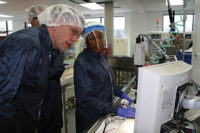Medical device housings can crack, discolor, and become brittle or sticky after repeated exposure to aggressive disinfectants. The choice of plastic can therefore have a significant impact on the service life of a medical device.
To help manufacturers select a plastic that withstands the full spectrum of disinfectants used to prevent hospital-acquired infections, Eastman Chemical Co. has developed a simple test to measure the performance of different plastics. The replicable, four-step process demonstrates the impact resistance and durability of plastics after being exposed to disinfectants or other chemicals.
The protocol is designed to help manufacturers choose a material for myriad medical device applications, such as MRI coils, ultrasound probes, buttons, handles and portable equipment prone to wear and tear on hospital floors.
“Medical device manufacturers are confronting the need to create housings that can withstand a broad spectrum of disinfectants and harsh solvents,” says Ellen Turner, Eastman’s global market development manager for specialty plastics in medical devices. “The right material choice can safeguard against repetitive failures and ensure greater patient safety and lower cost of ownership.”
The process has the following steps:
Step 1: Design a metal jig with enough strength to handle the testing. To accelerate environmental stress cracking, Eastman recommends a jig that induces a 1.5 percent strain on the test strips.
Step 2: Load the plastic test strips into the jigs. Remember to load a control sample that will not be exposed to the chemical.
Step 3: Apply a chemical, such as disinfectants, lipids, drugs or drug-carrier solvents, to the test strip using a presoaked piece of cotton. Enclose the entire sample jig in a plastic bag to prevent evaporation of the chemical, and leave it at room temperature for 24 hours.
Step 4: Unload the samples. Although physical changes may be readily apparent in some samples, engineers should not stop there. There may be damage that is invisible to the naked eye or that cannot be identified by weight or dimensional changes to the plastic.
To get a better idea of how the chemical may have affected the samples, engineers should run an impact test on the exposed and control samples. To best interpret results, record the impact strengths of the control and exposed samples to calculate the percentage of impact stress retention. High retention means better reliability after exposure.
Clorox Healthcare, a supplier of disinfectants for healthcare settings, has endorsed the four-step protocol as an effective tool to reliably assess the integrity of a device or surface after repeated cleaning and disinfection. “Eastman’s testing shows that the type of plastic used in these sensitive applications is critical to patient safety and device reliability,” says Laurie Rabens, senior product manager for marketing at Clorox Healthcare.
Eastman designed the protocol to compare the performance of its Tritan copolyester against other commonly used materials for medical devices, including polycarbonate, polycarbonate-ABS, polycarbonate-PBT and polycarbonate-PET. Eastman’s copolyesters are opaque, BPA-free polymers that offer excellent hydrolytic stability, good chemical resistance, and toughness. The materials can withstand rigorous use and disinfectants, while offering increased durability and reduced product failures for a wide variety of applications. Unlike other materials, the polymers do not become sticky to the touch, even after repeated cleaning with aggressive solvents.
“We encourage medical device developers and material specialists to put different plastics to the test in their own labs,” says Turner. “At the core of the scientific method is the ability to produce replicable results.”
For more information, visit www.eastman.com. To see a video of the test protocol, visit https://tinyurl.com/y9mu78oj.



